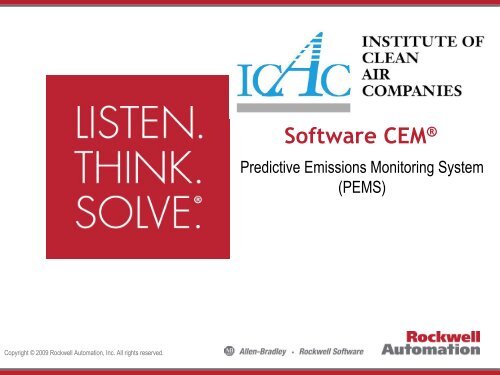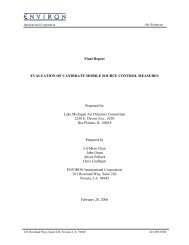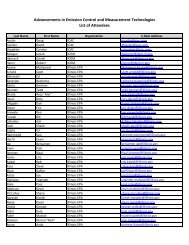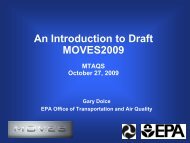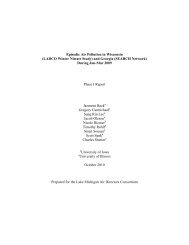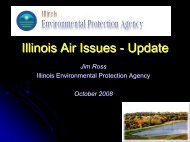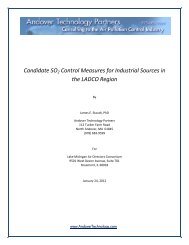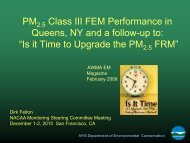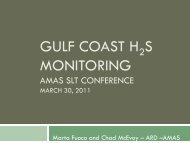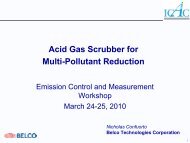Predictive Emissions Monitoring System (PEMS) - ladco
Predictive Emissions Monitoring System (PEMS) - ladco
Predictive Emissions Monitoring System (PEMS) - ladco
Create successful ePaper yourself
Turn your PDF publications into a flip-book with our unique Google optimized e-Paper software.
Software CEM ®<br />
<strong>Predictive</strong> <strong>Emissions</strong> <strong>Monitoring</strong> <strong>System</strong><br />
(PEMS)<br />
Copyright © 2009 Rockwell Automation, Inc. All rights reserved.
Copyright © 2009 Rockwell Software. All rights reserved.<br />
LADCO Workshop<br />
Software CEM ®<br />
<strong>Predictive</strong> <strong>Emissions</strong> <strong>Monitoring</strong> <strong>System</strong><br />
(PEMS)
(Confidential – For Internal Use Only)<br />
Agenda<br />
1. Introduction to Software CEM<br />
2. Software vs. Hardware<br />
3. Software vs. Software<br />
4. Summary<br />
5. Case Studies<br />
6. Discussion
Copyright © 2009 Rockwell Software. All rights reserved.<br />
Industry Challenges<br />
With regulations continually become more stringent<br />
many industries and processes now have the<br />
responsibility to account for their impact on the<br />
environment by replacing an aging system or<br />
implementing a new monitoring system that:<br />
– meets all regulatory demands<br />
– provides the highest levels of accuracy and reliability<br />
– ensures a sustainable long-term solution<br />
– minimizes the total cost of ownership
Copyright © 2009 Rockwell Software. All rights reserved.<br />
Solution – Software CEM ®<br />
A patented, nonlinear hybrid model-based, <strong>Predictive</strong> Emission<br />
<strong>Monitoring</strong> <strong>System</strong> (PEMS) that provides an alternative to hardwarebased<br />
Continuous Emission <strong>Monitoring</strong> <strong>System</strong> (CEMS).<br />
– Meets all performance criteria for regulatory certification<br />
– Cost effective solution powered by Pavilion8 software platform<br />
– Same platform for Model <strong>Predictive</strong> Control & Optimization<br />
– Rockwell Software is an active expert in<br />
technical support to regulatory<br />
agencies worldwide.<br />
• Patented - 1 st introduced in 1993<br />
• Over 250 installations in<br />
• Diverse applications
Solution - Software CEM ®<br />
• Software CEM uses a nonlinear hybrid modeling methodology<br />
– Models can be empirical, 1 st Principles based, or a combination of both.<br />
• Rockwell Software interfaces to all major DCSs, PLCs, and historians<br />
– Works with any recording and reporting system<br />
• Have interfaced with software developed in-house by end users<br />
– Pavilion OPC interface makes this especially easy by allowing users to interface<br />
with our Software CEM technology without the need to modify source code for<br />
over 1000 applications<br />
Copyright © 2009 Rockwell Software. All rights reserved.
Software CEM ® Applications<br />
Sources<br />
• Boilers<br />
• Turbines<br />
• Duct Burners<br />
• Dryers<br />
• Thermal Oxidizers<br />
• Reciprocating Engines<br />
• Regenerative Thermal<br />
Oxidizers<br />
• Process Heaters<br />
• Olefin Furnaces<br />
• Crude Heaters<br />
Industry Independent<br />
Fuel Types<br />
• Natural Gas<br />
• No. 2 & 6 Fuel Oils<br />
• Other Fuel Oils<br />
• Refinery Gas<br />
• Process Gas<br />
• Combined Fuels<br />
Copyright © 2009 Rockwell Software. All rights reserved.
Copyright © 2009 Rockwell Software. All rights reserved.<br />
Software CEM ® Advantages<br />
Cost Effective <strong>Monitoring</strong> & Compliance<br />
• A proven, model-based, software solution that leverages existing<br />
process instrumentation and data<br />
• Does not require additional capital equipment or real estate<br />
• Scalable solution that supports multiple Software CEMs in a<br />
standard office environment PC<br />
Highly Accurate & Reliable <strong>Emissions</strong> <strong>Monitoring</strong> & Reporting<br />
• Detects & alerts operator to sensor failures<br />
• Meets strict continuous emissions monitoring data availability<br />
requirements of 95% or more<br />
• Continues to operate in the event of sensor/instrument failure<br />
• Accurate emissions modeling with robust prediction capabilities<br />
Environmental and Industry Experience & Expertise<br />
• Proven solutions that meet unique, local regulatory requirements<br />
• Provides added confidence and reduced risk exposure
The Pavilion Software CEM ®<br />
Solution<br />
Copyright © 2009 Rockwell Software. All rights reserved.<br />
Consists of an emission model that<br />
reflects the relationship between<br />
process operations and ambient<br />
conditions to emissions.<br />
A patented, sensor validation<br />
system to ensure the accuracy of<br />
the predicted emissions data.
Software CEM ® -<br />
Sensor Validation<br />
Copyright © 2009 Rockwell Software. All rights reserved.<br />
• Definition<br />
– An algorithm imbedded in the emissions<br />
model to:<br />
• check raw inputs for validity<br />
• reconstruct variables that are out of<br />
specification or missing<br />
• predict what the failed sensor value should be.<br />
• Method<br />
– Development of a model for each key input<br />
– Model inputs accuracy with R 2 >95%<br />
• Results<br />
– Sensor Validation is a unique patented process that provides consistent<br />
achievement of the USEPA mandated 95% uptime
Software CEM ® -<br />
Sensor Validation Model<br />
Copyright © 2009 Rockwell Software. All rights reserved.<br />
This graph represents the real<br />
sensor (fuel flow) and the<br />
reconstructed value.<br />
This graph illustrates the other<br />
sensor values being used during<br />
the reconstruction period
Software CEM ® –<br />
Sensor Validation & PS-16<br />
Copyright © 2009 Rockwell Software. All rights reserved.<br />
• Sensor Validation is a requirement of PS-16: As defined in section 6.1.8 and 9.2:<br />
– “6.1.8 Sensor Evaluation <strong>System</strong>. Your PEMS must be designed to perform automatic<br />
or manual determination of defective sensors on at least a daily basis. This sensor<br />
evaluation system may consist of a sensor validation sub-model, a comparison of<br />
redundant sensors, a spot check of sensor input readings at a reference value,<br />
operation, or emission level, or other procedure that detects faulty or failed sensors.<br />
Some sensor evaluation systems generate substitute values (reconciled data) that are<br />
used when a sensor is perceived to have failed. You must obtain prior approval before<br />
using reconciled data.”<br />
– “9.2 Daily Sensor Evaluation Check. Your sensor evaluation system must check the<br />
integrity of each PEMS input at least daily.”<br />
• Rockwell Software provides a patented, real-time continuous sensor validation<br />
route with the ability to reconstruct data by using an independent model for each<br />
sensor. This virtually eliminates any missing data.
Software CEM ® -<br />
Model Validation<br />
• Model Validation<br />
– A standard feature on Software CEM that provide a daily check on the model’s<br />
integrity; verifying that no unauthorized changes have occurred<br />
– Note: the model does not change only the process changes with time<br />
• Definition<br />
– A routine that applies known sensor input values and verifies the results against<br />
known output values<br />
• Method<br />
– Predetermined input values are applied for low, medium, & high ranges<br />
– Output values are then calculated by the model<br />
– Calculated values are then compared to the known output values developed during<br />
modeling and RATA<br />
• Results<br />
– An equivalency to an EPA mandated Quarterly audit.<br />
Copyright © 2009 Rockwell Software. All rights reserved.
Software CEM ® RATA Accuracy<br />
within + 7.5% Scale<br />
Copyright © 2009 Rockwell Software. All rights reserved.
Software CEM ®<br />
Certification Rate – 100%<br />
• Based on a USEPA Review of Software CEM Installations<br />
– Initial Certification Tests<br />
• Average Relative Accuracy (20% or less is goal):<br />
– NOx –6.4%, O2 –4.9%<br />
• Less than 7.5% Relative Accuracy<br />
– NOx – 97 (66%), O2 – 105 (72%)<br />
– Ongoing Relative Accuracy Tests<br />
• Average Relative Accuracy:<br />
– NOx –3.2%,O2–3.9%<br />
• Less than 7.5% Relative Accuracy<br />
– NOx – 132 (95%)<br />
– O2 – 119 (86%)<br />
– No failures<br />
– Demonstrated as accurate as CEMS over tougher test<br />
Copyright © 2009 Rockwell Software. All rights reserved.
Sustaining Software CEM ®<br />
• Retaining accuracy over long periods of time is a function of physical<br />
equipment change and not the software application<br />
– Greater than1,600 stack years<br />
– Greater than 2,000 RATA (without failure)<br />
• Greater than 100 of our installed Software CEMs are customer or<br />
independently maintained and supported<br />
– Greater than 40% of all installations<br />
100% data availability lowers the risk of inaccurate reporting with the use of continuous,<br />
real-time sensor validation<br />
Copyright © 2009 Rockwell Software. All rights reserved.
Software CEM<br />
vs.<br />
Hardware CEM<br />
Copyright © 2009 Rockwell Automation, Inc. All rights reserved.
Software CEM ®<br />
Lower Total Cost of Ownership<br />
Cost Analysis Based on USEPA CEM Model<br />
Copyright © 2009 Rockwell Software. All rights reserved.
Increasing Cost of<br />
Hardware Validation<br />
• Hardware CEM (analyzers and system) accuracy is verified daily due to<br />
equipment drift and aging<br />
– Verification is performed with costly Calibration Gas<br />
• Typical 2% certified gas is used<br />
– Uptime as required by agencies is >95%<br />
• Continuous routine maintenance is required for operation<br />
• Yearly sustainable operating costs are more then double that of Software CEM<br />
• Hardware CEM Linearity is verified quarterly via a Calibration Gas Audit<br />
(CGA)<br />
– Verification is performed with multiple Calibration Gases that are different then the<br />
gases used for Daily Cal-Check gas<br />
• 3 level (low, mid, & high range) gases are used for linearity<br />
– 1% Protocol gas is used<br />
Copyright © 2009 Rockwell Software. All rights reserved.
Software CEM ® vs.<br />
Hardware CEM Validation<br />
• Software CEM sensor validation routine is equivalent to the daily Cal-gas<br />
Check for hardware CEMS<br />
– Software CEM validates sensors once per minute versus hardware CEM once every<br />
24 hours<br />
• 1440 times to 1 in a 24 hour period.<br />
– Uptime as required by agencies is >95%<br />
• Hardware CEM targets 95% (98% for Part 75)<br />
• Software CEM is near 100%<br />
• Software CEM Model Validation routine is equivalent to the CGA for a<br />
hardware CEM<br />
– Software CEM validates the model once per day versus hardware CEM once per<br />
every calendar quarter<br />
• 90 times to 1 in a calendar quarter<br />
Copyright © 2009 Rockwell Software. All rights reserved.
Copyright © 2009 Rockwell Automation, Inc. All rights reserved.<br />
Model-based Software<br />
CEM<br />
vs.<br />
Other Software<br />
Methodologies
Software CEM ® Methodologies<br />
• Nonlinear hybrid modeling methodology versus a<br />
statistical methodology (i.e. table look-up)<br />
– A true Software CEM model is robust for a wider range outside of<br />
the RATA range<br />
– The table look-up is similar to a classic data substitution<br />
method and is more dependent upon the amount and diversity<br />
of data collected<br />
• A table look-up method cannot interpolate or<br />
extrapolate operating conditions that are not already in<br />
the table<br />
• Both methodologies can be built directly from historical<br />
data (provided hardware-CEMS data is available) and<br />
require no additional inputs<br />
Copyright © 2009 Rockwell Software. All rights reserved.
Software CEM ® Accuracy<br />
• Nonlinear Hybrid modeling methodology employs extrapolation (an<br />
accepted practice by PS-16) that allows initial testing to be held at a<br />
minimum by reducing the number of test points required during model<br />
development<br />
– Table Look-up systems must include the entire range of the measurement envelope<br />
in order not to have “holes” in the data table. These “holes” will result in unsupported<br />
data in the table and result in a missing data flag.<br />
Look-up table data does not extrapolate thus requiring more testing than an empirical<br />
equation-based models<br />
Copyright © 2009 Rockwell Software. All rights reserved.
Ambient Conditions –<br />
Compliance Accuracy<br />
Copyright © 2009 Rockwell Software. All rights reserved.<br />
• The Pavilion modeling methodology does not require additional input<br />
sensors such as ambient humidity<br />
– Uses ambient sensors used for high accuracy because:<br />
– As NOx levels come down, ambient conditions have a more dramatic<br />
affect on NOx calculations<br />
– Omitting or using surrogates for this input places the system at risk of<br />
misrepresenting emissions<br />
• Ambient sensors not used with:<br />
– Steam injection, water misting, flue gas recirculation<br />
– PS-16 (6.1.4 Ambient Conditions) requires ambient condition affects<br />
PS-16 states that if ambient sensors are not used then sufficient data must be provided to<br />
show that ambient conditions do not affect the model accuracy
Copyright © 2009 Rockwell Software. All rights reserved.<br />
Impact of Ambient Conditions<br />
39.89ppm NOx<br />
Weather and seasonal<br />
changes can result in<br />
humidity changes as<br />
much as 50%.<br />
75%<br />
A 25% change in Humidity<br />
results in a 12% change in<br />
the NOx output.<br />
50%<br />
46.11ppm NOx
Software CEM ®<br />
Summary<br />
Copyright © 2009 Rockwell Automation, Inc. All rights reserved.
Copyright © 2009 Rockwell Software. All rights reserved.<br />
How is Software CEM ® Different?<br />
Cost Effective <strong>Monitoring</strong> & Compliance<br />
• Up to 50% less cost to install and maintain than hardware CEMS<br />
• No specially trained technicians/dangerous environments/hazardous materials<br />
• No consumable products, thus no increase in material operating costs<br />
Highly Accurate & Reliable <strong>Emissions</strong> <strong>Monitoring</strong> & Reporting<br />
• Continuous, real time sensor validation & emission performance<br />
• Meets or exceeds regulatory uptime requirements (~99% - 100%)<br />
• 100% data validation lowers the risk of inaccurate reporting<br />
Environmental and Industry Experience & Expertise<br />
• 1 st to patent & introduce (1993) a software-based alternative<br />
• 100% Certification Record with 250+ PEMS installations<br />
• Proven global applications in major industries<br />
• Active member of environmental quality technical support groups
Copyright © 2009 Rockwell Software. All rights reserved.<br />
Software CEM ® Highlights<br />
• Nonlinear Hybrid Modeling Methodology<br />
– Reliability based on real-time continuous sensor validation<br />
– High accuracy by design using non-linear process modeling<br />
• Data set is not the model<br />
– Once the model is validated it no longer uses the test data<br />
• Meets all USEPA requirements for PEMS<br />
– 40 CFR Part75; Subpart E for “Alternative <strong>Monitoring</strong> <strong>System</strong>s”<br />
– 40 CFR Part 60; Appendix A, Performance Specification 16 (PS-16)<br />
• Over 250 applications of diverse emission sources and types as well<br />
as local, state, national and global regulatory experience<br />
– Greater than 40% of installed Software CEMs are customer or independently<br />
maintained and supported
Software CEM ®<br />
Case Studies<br />
Copyright © 2009 Rockwell Automation, Inc. All rights reserved.
Copyright © 2009 Rockwell Software. All rights reserved.<br />
Challenges<br />
Netherlands NO x <strong>Emissions</strong> Credit Trading<br />
• Continuous NO x <strong>Emissions</strong> <strong>Monitoring</strong> if > 100 MWth<br />
• CEMS (hardware) or PEMS (software)<br />
Pernis, The Netherlands<br />
Performance Requirements<br />
• En-14181: QA standards for continuous emissions<br />
monitoring at stationary sources<br />
– NO x accuracy ± 20%<br />
250<br />
– Availability > 97%<br />
Gas Turbine<br />
• 160 MWth, 19 burners, dry low NOx<br />
Extremely Short Project Schedule<br />
• Urgently replace poor performing monitoring system<br />
NOx [ppmv]<br />
NO x profile relative to burners in operation<br />
200<br />
150<br />
100<br />
5<br />
15<br />
25<br />
35<br />
45<br />
55<br />
65<br />
75<br />
85<br />
95<br />
50<br />
0<br />
Gas turbine<br />
Load [%]<br />
20<br />
18<br />
16<br />
14<br />
12<br />
10<br />
8<br />
6<br />
4<br />
2<br />
0<br />
Burners [#]<br />
NOx [ppm]<br />
Burners
The Benefits<br />
• Performance<br />
– Accurately and reliably predicts NOx emissions on complex sources such as<br />
the dry low NOx gas turbine:<br />
• NOx emissions accuracy +/- 9.2% (exceeds the requirement of +/- 20%)<br />
• Patented Sensor Validation provides 100% availability<br />
• Fully automated quality assurance testing<br />
– Minimal maintenance required (lower TCO)<br />
• Met Tight Project Schedule<br />
– Project duration: < 5 weeks including:<br />
• P.O. and contract completion<br />
• Model development and deployment<br />
• Stack testing<br />
• Certification in accordance with EN-14181<br />
• Fast time to value<br />
– Quicker ROI<br />
Copyright © 2009 Rockwell Software. All rights reserved.
Boilers with<br />
Ultra Low NOx Burner Technology<br />
Challenges<br />
• Subpart Db Boiler (total 3)<br />
– Industrial Powerhouse<br />
– 3 – 180MMBTU<br />
• New Air Permit required NOx outputs below 10ppm<br />
– New permit required reconfiguration of boilers<br />
– Installation of Ultra Low NOx burners and<br />
– Firebox extension<br />
• Retrain model for new configuration<br />
– Time for all 3 boilers under 8 weeks<br />
• First Ultra Low NOx burner application for a PEM<br />
• Passed USEPA and TCEQ certification<br />
– Better then 7.5% relative accuracy<br />
Copyright © 2009 Rockwell Software. All rights reserved.
Boilers with<br />
Ultra Low NOx Burner Technology<br />
Benefits<br />
• Existing Software CEM reconfigured for low cost<br />
• No replacement with Hardware CEM<br />
• Cost savings<br />
– Over $1MM in saving over 10 year operating period<br />
– No additional personnel needed for HWCEM maintenance<br />
– No calibration gases required<br />
Copyright © 2009 Rockwell Software. All rights reserved.
An Gas Compressor Station<br />
Ultra Low NOx SCR Application<br />
Challenges<br />
• Subpart Db Boiler (total 1)<br />
– Oil & Gas Compressor and Stripping Station<br />
– 1 – 280MMBTU<br />
• New Air Permit required NOx outputs below 10ppm<br />
– New permit required reconfiguration of boilers<br />
– Installation of SCR with ammonia injection<br />
– New boiler installation<br />
• Retrain model for new configuration<br />
– Model Boiler and SCR outputs<br />
• First Ultra Low NOx SCR application for a PEMS<br />
• Passed USEPA and TCEQ certification<br />
– Better then 6% relative accuracy<br />
Copyright © 2009 Rockwell Software. All rights reserved.
An Gas Compressor Station<br />
Ultra Low NOx SCR Application<br />
Benefits<br />
• Existing Software CEM reconfigured for low cost<br />
• No replacement with Hardware CEM<br />
• Cost savings<br />
– Over $300K in saving over 10 year operating period<br />
– No additional personnel needed for HWCEM maintenance<br />
– No calibration gases required<br />
Copyright © 2009 Rockwell Software. All rights reserved.


